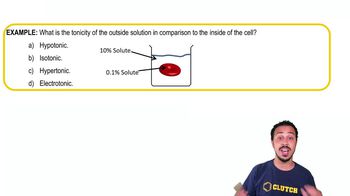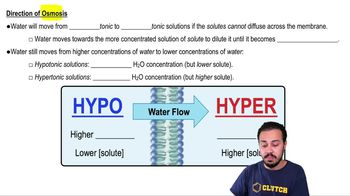6. The Membrane
Osmosis
Learn with other creators
Practice this topic
- Multiple Choice
Osmosis is best defined as the movement of:
7016views62rank - Multiple Choice
Which direction would you expect water to move across the cell membrane?
5009views65rank - Multiple Choice
Plants become turgid when placed in this type of solution:
4215views47rank - Multiple Choice
What would you expect to happen to the cell under the following conditions?
4402views56rank2comments - Textbook Question
A cell is placed in a solution that is hypotonic to the cell. Which of the following best describes movement of water in this situation?
a. Water will only flow into the cell.
b. Water will only flow out of the cell.
c. Water will flow into and out of the cell, but the overall net movement will be out of the cell.
d. Water will flow into and out of the cell, but the overall net movement will be into the cell.
1879views - Textbook Question
If a solution surrounding a cell is hypertonic relative to the inside of the cell, how will water move?
a. It will move into the cell via osmosis.
b. It will move out of the cell via osmosis.
c. It will not move, because equilibrium exists.
d. It will evaporate from the cell surface more rapidly.
1992views - Textbook Question
What two conditions must be present for osmosis to occur? Integral membrane proteins are anchored in lipid bilayers.
1594views - Textbook Question
A plant cell placed in distilled water will ______________; an animal cell placed in distilled water will ______________.
a. Burst … burst
b. Become flaccid … shrivel
c. Become turgid … be normal in shape
d. Become turgid … burst
2524views












